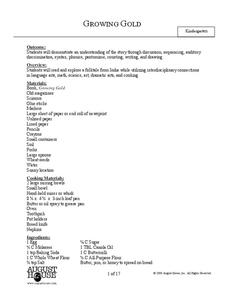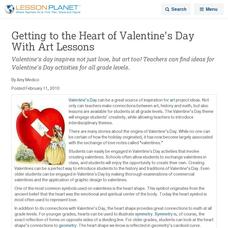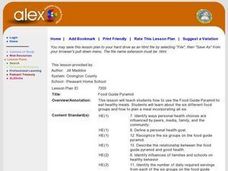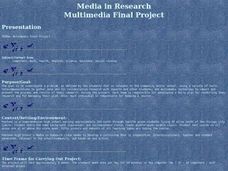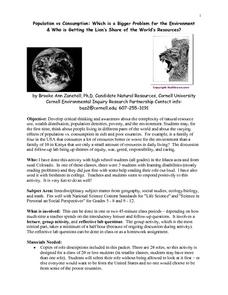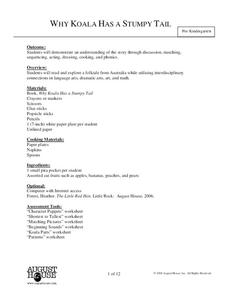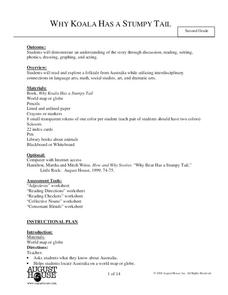Curated OER
Growing Gold
Young scholars read and explore a folktale from India. In this folktale activity, students read the book Growing Gold and discuss the events from the tale. Young scholars complete a phonics worksheet which incorporates the rhyming words...
Curated OER
Getting to the Heart of Valentine's Day With Art Lessons
Valentine's day inspires not just love, but art too! Teachers can find ideas for Valentine's Day activities for all grade levels.
Curated OER
Navigation
Students explain that globes are the best way to show positions of places, but flat maps are portable and can show great detail. They make a mercator projection of the route Lewis and Clark took on their journey.
Curated OER
American Civil Rights Movement, Photo Essay
Students view photographs from the Civil Rights Movement and write an essay from the point of view of someone in the photograph. They artistically represent various aspects of the Movement.
Alabama Learning Exchange
Food Guide Pyramid - TV and Peers
Students identify foods that belong in each group on the food guide pyramid. They discuss how TV and peers may negatively influence eating habits.
Curated OER
Edgar Allan Poe: an Author Unit
Eighth graders study the life and writing of Edgar Allan Poe in this unit of work.
Curated OER
Media in Research Multimedia Final Project
Students work cooperatively in groups to research a topic of their choice. They create a multimedia presentation of the information researched. Throughout the project they generate their own progress journals.
Curated OER
El Nino
Students explain what El Nino is, where it is located and how it is created. They describe the weather changes caused by El Nino. They draw the patterns of El Nino on a world map. They predict economic effects El Nino has on the areas it...
Curated OER
Propaganda & Persuasive Techniques: Do You Buy It?
Fifth graders investigate the basic persuasive techniques employed in advertising. They identify three examples of propaganda/persuasive techniques, complete an observation chart, take an advertising quiz, complete a spreadsheet that...
Curated OER
How Plants Help Us Breathe
Third graders discuss how humans breathe and how plants help us to stay alive. In groups, they identify and label the different parts of plants and describe their functions. They compare and contrast the ways plants and animals breathe...
Curated OER
Population Vs Consumption: Which is a Bigger Problem for the Environment & Who is Getting the Lion's Share of the World's Resources?
Students develop critical thinking and awareness about the complexity of natural resource use, wealth distribution, population densities, poverty, and the environment. They think about people living in different parts of the world and...
Curated OER
Pollution in the Air and the Water Pollution Solution
Students explore air pollution. In this ecology and air pollution instructional activity, students perform an experiment in which a Vaseline coated lid is placed inside and outside the classroom. Students make predictions and then record...
Curated OER
Alice Computer Programming
Students explore multimedia components. In this science inquiry lesson, students read "Invitation to the Game" by Monica Hughes and they use the Alice Computer Programming System to better understand population dynamics.
Curated OER
The Archer and The Sun
First graders explore Chinese folktales. In this Chinese folktale lesson ,students read Chinese folktales, locate China on a map, and color the Chinese flag. Students are given sentence strips to hold and must arrange themselves in the...
Curated OER
Rooster's Night Out
Students explore folktales. For this folktale lesson, students listen to a story from another country and discuss the characters. Students retell the story using puppets and do coloring sheets. Students do a sequencing cut and paste...
Curated OER
Why Koala Has A Stumpy Tail
Students practice reading comprehension of an Australian folktale. In this Australian folktale lesson, students read the story, Why Koala Has a Stumpy Tail, before completing retells with character puppets, discussing friendship, and...
Curated OER
Why Koala Has A Stumpy Tail
Students examine Australian folktales. In this folktales lesson, students read the Australian folktale, Why Koala Has a Stumpy Tale. Students list characteristics of the characters from the book. Students act out these characteristics...
Curated OER
Why Koala Has A Stumpy Tail
First graders read the story Why Koala Has A Stumpy Tail and complete language arts activities with it. Students have discussions, read, write, spell, and act out the story.
Curated OER
Why Koala Has a Stumpy Tail
Second graders explore Australian folktales. In this folktales lesson, 2nd graders gain knowledge about Australia and it's animals by reading books and discussion. Students find the adjectives in the book and write what they describe....
Curated OER
Leaping!
Students properly leap and measure their distance. For this leaping lesson, students practice leaping for accuracy and proper form. Students estimate their leaps and measure with rulers. Students determine distance covered by the entire...
Curated OER
Monitoring an Epidemic: Analyzing Through Graphical Displays Factors Relating to the Spread of HIV/AIDS
Tenth graders differentiate pandemic and epidemic. In this health science lesson plan, 10th graders analyze how HIV and AIDS affect different countries. They construct and interpret different types of graphs.
Curated OER
Aqueduct Architecture: Moving Water to the Masses in Ancient Rome
Ninth graders compare ancient and modern technology in water transporting. In this instructional activity on the evolution of the aqueduct, 9th graders build a working aqueduct model and examine its components. They explain the...
Curated OER
Art and Anatomy: The Vitruvian Teen
Twelfth graders create an artistic version of a Vetruvian teen. For this anatomy lesson, 12th graders design an experiment to test the theory of the ideally proportioned man. They present their findings in class.
Curated OER
Integrating Science and Literacy Through Novel Studies
You can use "The Toothpaste Millionaire" and other outstanding fiction to integrate science and literacy.


